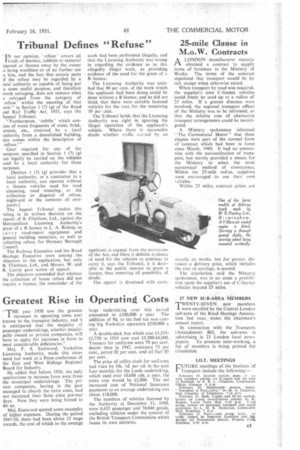Tribunal Defines "Refuse"
Page 37

If you've noticed an error in this article please click here to report it so we can fix it.
• IN our opinion, refuse' covers all
1 kinds of detritus, rubbish or material ejected or thrown away by the owner Ls being worthless or of no further use o him, and the fact that certain parts if the refuse may be regarded by a ocal authority as capable of being put o some useful purpose, and therefore vorth salvaging, does not remove what s salvaged from the category of refuse' within the meaning of that erm" in Section 1 (7) (g) of the Road ind Rail Traffic Act, 1933, says the kppeal Tribunal.
"Furthermore, rubble' which conLists of waste fragments of stone, brick, :ement, etc., removed by a local iuthority from a demolished building, ilso comes within the description of refuse.'"
Gear required for any of the surposes specified in Section 1 (7) (g) :an legally be carried on the vehicles used by a local authority for those surposes.
iSection 1 (7) (g) provides that a local authority, or a contractor to a local authority, can operate without a licence vehicles used for road cleansing, road watering, or the collection or disposal of refuse, night-soil or the contents of cesspools.] The Appeal Tribunal makes this 'tiling, in its written decision on the ippeal of B. Flintham, Ltd., against the Metropolitan Licensing Authority's grant of a B licence to L. A. Bishop, to sorry road-repair equipment and general building materials, as well as sollecting refuse. for Hornsey Borough Council.
The Railway Executive and the Road Haulage Executive were among the objectors to the application, but only B. Flintham, Ltd., and Messrs. W. and R. Corrie gave notice of appeal.
The objectors contended that whereas the collection of house refuse did not require a licence, the remainder of the work had been performed illegally, and' that the Licensing Authority was wrong in regarding the evidence as to this allegedly illegal work, as providing evidence of the need for the grant of a B licence.
The Licensing Authority was satisfied that 90 per cent. of the work which the applicant had been doing could be done without a B licence, and he did not think that there were suitable licensed vehicles for the area for the remaining 10 per cent.
The Tribunal holds that the Licensing Authority was right in ignoring the illegal operation of the applicant's vehicle. Where there is reasonable doubt whether traffic carried by an




















































































